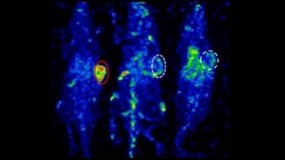The γ-CUBE is a high-performance preclinical SPECT imager to track and quantify molecular processes
By labelling peptides, proteins, antibodies and many small molecules, with a radioisotope, virtually any molecular process can be imaged non-invasively and longitudinally with a SPECT imager.
SPECT compatible radioisotopes are typically useful for imaging longer biological half-life processes. Image and quantify the bio-distribution of monoclonal antibodies (mAbs) and peptides, (stem) cell imaging, and more.
Intuitive and wireless acquisition software combined with our multimodal small animal bed allow for easy and modular multimodal imaging along with the X-CUBE (CT) and β-CUBE (PET).
γ-CUBE preclinical SPECT imager testimonials
|
γ-CUBE |
X-CUBE |
β-CUBE |
|
| GP mouse protocol | |||
|
Field Of View
axial x transaxial
|
12 mm x 30 mm | 35 mm x 63 mm | 130 mm x 72 mm |
|
Spatial Resolution
*general purpose mouse collimator
|
< 0.6 mm | 0.05 mm | < 1 mm |
| Sensitivity | 0.12% | - | > 10% |
|
Reconstruction Code
on board GPU-based
|
3D MLEM, 3D OSEM | FDK, ISRA | FBP, 3D MLEM, 3D OSEM |
|
Weight
over footprint of 54cm x 54cm
|
< 80 kg | < 100 kg | < 90 kg |
Existing γ-CUBE customers
Click on the tabs below to find out more about our customers, and how they are using the γ-CUBE in their facilities.
Documents
-
Molecubes Brochure 2022
Download (3.66 MB) -
Molecubes - REMI External Reconstruction Server
Download (1.42 MB) -
Molecubes - Mouse Hotel
Download (1.64 MB)
Catalogues
-
Preclincial Brochure EU Version 1.1
Download (3.7 MB)







